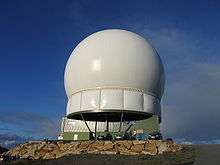Globus II

Globus II is a radar station located at 70°22′02″N 31°07′38″E / 70.3671°N 31.1271°E in Vardø, Norway, near the Russian border.[1]
Purpose and use
The site is administrated by the Norwegian Intelligence Service, which states that the radar is used for:[2]
- Space surveillance
- Surveillance of areas of national interest abroad
- Gather information of interest to research and development
- Track aircraft of all types up to a range of 7,000 km
The radar was previously known as "Have Stare" and located at Vandenberg Air Force Base, California. It was made by Raytheon, who previously described it on their website as a radar "originally designed to collect intelligence data against ballistic missiles". The website has since then been removed by request of the US DoD.[3][4]
The radar, which uses a mechanically steered 27-meter dish antenna, is believed to have similar, though probably somewhat more limited, capabilities as the newer American Sea-based X-band Radar used in the Anti-ballistic missile system.
Administration and funding
The radar is administered by the Norwegian Intelligence Service. It is however believed to be connected to the US radar network. Although the cost of the radar is secret it is believed to have cost more than 100 million US dollars[5] and that it was financed by the United States. The Norwegian intelligence service claims that it is operated by Norwegian personnel only and that data is not transferred real-time. What is to be considered real-time is however disputed as such radar-stations collect too much information for it to be transferred live. Instead, information is typically automatically filtered on location and transferred in batches every 30–90 seconds.
References
- ↑ Globus II/Have Stare Sourcebook
- ↑ Globus II from the Norwegian National Intelligence Service (in Norwegian)
- ↑ Raytheon Systems Company (15 November 1999). "AN/FPS-129 HAVE STARE" (PDF). Center for Arms Control, Energy and Environmental Studies. Retrieved 27 May 2016.
- ↑ Sellev, Ingeåg (March–April 2000). "Vardo exposed". "Bulletin of the Atomic Scientists". doi:10.2968/056002009. Retrieved 2009-08-04. External link in
|publisher=(help) - ↑ How A Storm Spread A Cold War Chill